
This is going to be an exciting blog guys. We’re going to take apart the Cisco 2800 series generation one router and look at all the internal components. Let’s dive in, so this is a Cisco 2800, a 2811, to be exact. This is a slightly older router; I believe Cisco stopped supporting them in 2016. This router was a workhorse of the enterprise and has seen so many different installations. It’s an incredible workhorse for Cisco, that’s for sure. We’re going to dive into this router and look at all the internal components. To get started, I want to describe what’s on the outside here. All routers do look a little bit different, but generally, they’re going to have similar components. This will give you a really good idea of what to expect when you see any router out in the field. The Cisco 2811 router is a business or enterprise grade router. Looking here on the front, we see we just have the front bezel and some important ports here on the front.
Console Port – We have our console port where we plug in to actually configure the router.

Auxiliary Port – We have an auxiliary port which is kind of like our back door, if we ever lose access to the console port.

USB Port – We also have a couple USB ports. We can plug in any kind of USB stick to just use that as an additional memory source.
Compact Flash –  Our flash card that we can store things on the router internally. We can actually just pop this thing out and use it in a new router if we ever needed to replace the router. It’s nice to have a removable compact flash and all modern routers actually have that.
Our flash card that we can store things on the router internally. We can actually just pop this thing out and use it in a new router if we ever needed to replace the router. It’s nice to have a removable compact flash and all modern routers actually have that.
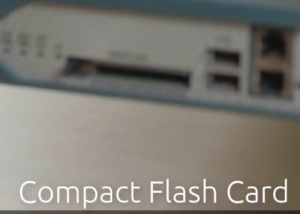
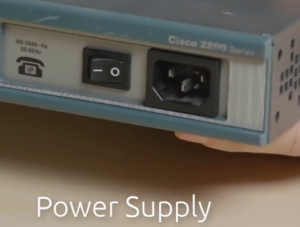 Power Supply – We have our power supply. Now, these 2800 series routers actually came originally out of the box without a POE power supply, it could not support the phones on the switches. On the power supply it says IP on the front and it has a picture of a phone there meaning that this power supply can power up phones plugging into this router or into the switch that we have plugged into the router. This power supply is a Power over Ethernet power supply. Maybe you’re thinking why do you have a Power over Ethernet power supply in a router? Well, the answer is because this router comes with an Ethernet switch. The Power over Ethernet power supply we have in here has additional power so that we can actually power this Ethernet switch and also power any phones or wireless access points that are plugged into the switch. This is an entire Ethernet switch plugged into this router. Why would we have a switch as part of a router? Well, this router is actually a branch router.
Power Supply – We have our power supply. Now, these 2800 series routers actually came originally out of the box without a POE power supply, it could not support the phones on the switches. On the power supply it says IP on the front and it has a picture of a phone there meaning that this power supply can power up phones plugging into this router or into the switch that we have plugged into the router. This power supply is a Power over Ethernet power supply. Maybe you’re thinking why do you have a Power over Ethernet power supply in a router? Well, the answer is because this router comes with an Ethernet switch. The Power over Ethernet power supply we have in here has additional power so that we can actually power this Ethernet switch and also power any phones or wireless access points that are plugged into the switch. This is an entire Ethernet switch plugged into this router. Why would we have a switch as part of a router? Well, this router is actually a branch router.
Let’s say you have a bank, for example and you have a branch office at one of the bank’s branches. Well at that branch, you’re going to need a device to handle all the network connections and in this case, we have a branch router that can handle the routing. We also wanted to slide a switch in here because we can easily then just support hosts, like a normal switch would all within the same device. So basically it saves us equipment. We could do the same job with a complete separate switch. Anyhow, just to explain to you guys that we do have a complete module here.
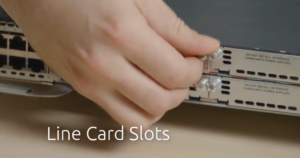 Line Cards –
Line Cards –  We also have our line cards here in the back. The purpose of these line cards is so that we can change the type of interface we have connecting out to the WAN or any type of connection that we have in our network. In this case here we have a T1 line card. It must have been connected over a T1 circuit because this is a T1 DSU CSU old school T1 card. Now, if we were connecting to something else, maybe, let’s say a Fast Ethernet, we could pop a Fast Ethernet card in here, or we could also pop a voice card in here. We can use these expansion slots to configure and add any type of connectivity we want to this router. That’s what’s so great about enterprise grade routers.
We also have our line cards here in the back. The purpose of these line cards is so that we can change the type of interface we have connecting out to the WAN or any type of connection that we have in our network. In this case here we have a T1 line card. It must have been connected over a T1 circuit because this is a T1 DSU CSU old school T1 card. Now, if we were connecting to something else, maybe, let’s say a Fast Ethernet, we could pop a Fast Ethernet card in here, or we could also pop a voice card in here. We can use these expansion slots to configure and add any type of connectivity we want to this router. That’s what’s so great about enterprise grade routers.
Ethernet Switch – You can see that literally it is an entire switch on its own and this is the interface where it actually connects to the router mainboard.
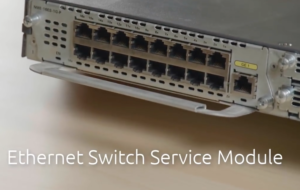
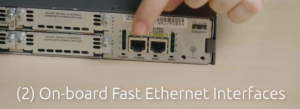 Onboard Interfaces –
Onboard Interfaces –  We also have a couple on board interfaces that come no matter what on this router. So, if you were to buy this router completely bare bones, it would have at least two Ethernet interfaces. In the case of this router, these are Fast Ethernet or 100 megabit per second Ethernet interfaces. On more modern routers, like the ASR G2, or even the 4000 series Cisco routers, these are going to be gigabit ports onboard. That’s one disadvantage if people still do have these 2000 series in their network, although these routers will work pretty well. So, that’s our onboard interfaces.
We also have a couple on board interfaces that come no matter what on this router. So, if you were to buy this router completely bare bones, it would have at least two Ethernet interfaces. In the case of this router, these are Fast Ethernet or 100 megabit per second Ethernet interfaces. On more modern routers, like the ASR G2, or even the 4000 series Cisco routers, these are going to be gigabit ports onboard. That’s one disadvantage if people still do have these 2000 series in their network, although these routers will work pretty well. So, that’s our onboard interfaces.
Ribbon Cable – The ribbon cable is what passes all of the data from any of our slots or any of the ports, including the flash board and passes it over to the main board. So I’ve just disconnected all those from the main board.
Internal Components
 We have a fan for our airflow component and I have a lot of the classic stuff here. For example, it’s a router, so it’s going to have a CPU, a ROM chip, and also NVRAM. Now, these three items, the CPU, which is the processor, the Read Only Memory, the ROM, which is where our ROM monitor, and boot PROM and boot files are stored. We also have NVRAM, our non volatile RAM, that’s part of the motherboard as well. Those three items are built into the board. Then we also do have our Random Access Memory, and RPMs, and also our advanced integration module.
We have a fan for our airflow component and I have a lot of the classic stuff here. For example, it’s a router, so it’s going to have a CPU, a ROM chip, and also NVRAM. Now, these three items, the CPU, which is the processor, the Read Only Memory, the ROM, which is where our ROM monitor, and boot PROM and boot files are stored. We also have NVRAM, our non volatile RAM, that’s part of the motherboard as well. Those three items are built into the board. Then we also do have our Random Access Memory, and RPMs, and also our advanced integration module.
RELATED: Want to stand out from other IT candidates? The FSNA & FSNP could be your answer
So starting here with the Random Access Memory card, this is just like you would see in a personal computer. We can just pull the tabs and pop out the RAM chip. This is an older router and has 256 megabytes of RAM. On modern cards you’ll see at least one gigabyte. This next chip here that looks just like a RAM chip is actually something called a PVDM. The purpose of a PVDM is to host the DSPs or the digital signal processors. This is necessary for things like transcoding voice calls and also just handling voice calls. If you have a traditional PRI or a T1 circuit with a voice PRI, you’re going to need a PDM to be able to handle those calls. Depending on the amount of memory you have on your PBM determines how many calls can actually pass through the router. Now, if you’re working with newer Voice over IP technology, like SIP, for example, you don’t need the PVDF just to process calls. What you do still need it for are things like transcoding. Anyhow, my point here is this is an extra card just for your voice traffic and it’s like a RAM chip for voice. Your PVDF that’s in the router as well. So, those are our memory components. The next thing I’d like to look at here is the aim module. This is the advanced integration module on these series of routers, we had an additional module we needed in order to do things like encryption. If we wanted to have VPN traffic passing through this router, we would have to create a VPN on this router, and we would have to have this additional advanced integration module. This module has its own memory and its own CPU and everything.
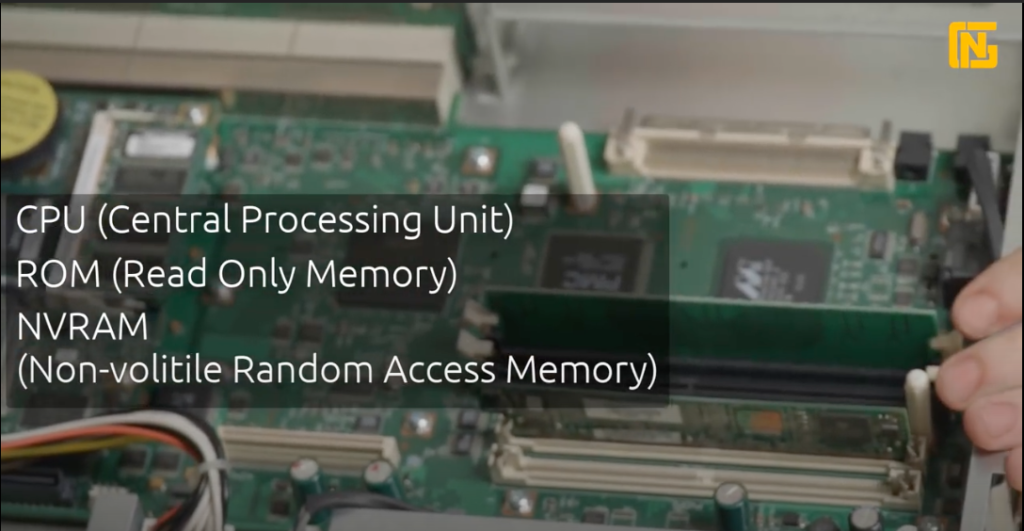
You may be thinking, why doesn’t he have on an ESD strap? Well, I’m really not concerned about this router it is very old. For newer stuff, you would want to have an ESD strap, if you wanted to make sure you didn’t have any static electricity passing your body and burn out a circuit board component. There are different types of modules and feature cards that we can put in our routers. That’s one great thing about Cisco Systems on the forefront of routing for so many years, is they really lead the pack in the versatility of routers and you can see we can really customize these things just like you can customize a home computer or PC. All right, we have the router pretty much down just to its mainboard and you can see this is just like if you were to take apart a computer and unplug all the components and just be left with the motherboard. That’s pretty much what we just did for this router.
Conclusion
So now guys, I’m going to go ahead and put our router back together. Wasn’t that awesome guys, I know I really enjoyed it.[a] I hope you learned a lot about what’s on the inside of a Cisco router. Like I said before, it’s done a lot of work for us. These are great routers and if you haven’t purchased a router for your lab yet, this is actually a good one. You can take it apart. Look at the inside yourself and you can find these guys on eBay for relatively cheap these days.
For full-time IT training programs, visit NexGenT.com.


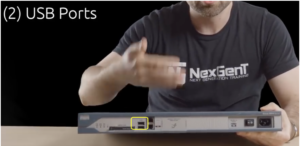
0 Comments
Trackbacks/Pingbacks